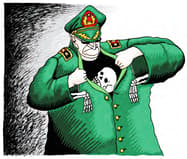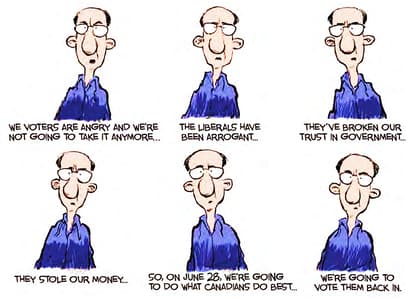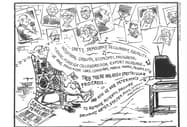
This cartoon is from Brazil, a country with a long history of dictatorships. It is entitled “The Hidden Side of Dictatorship”.
a) Which hidden sides does this cartoon depict?
b) Is it necessary for every dictatorship to have a hidden side?


Important Questions on What Is Democracy? Why Democracy?
This cartoon was published in Canada just before its parliamentary elections of . Everyone, including the cartoonist, expected the Liberal party to win once again. When the results came, the Liberal Party lost the elections.
Is this cartoon an argument against democracy or for democracy?
Read the given information and answer the following question.
Rajesh and Muzaffar read an article. It showed that no democracy has ever gone to war with another democracy. Wars take place only when one of the two governments is non-democratic. The article said that this was a great merit of democracy. After reading the essay, Rajesh and Muzaffar had different reactions. Rajesh said that this was not a good argument for democracy. It was just a matter of chance. It is possible that future democracies may have wars. Muzaffar said that it could not be a matter of chance. Democracies take decisions in such a way that it reduces the chances of war.
Which of the two positions do you agree with and why?
This famous cartoon by R. K. Laxman comments on the celebrations of the fifty years of independence.
a) How many images on the wall do you recognise?
b) Do many common people feel the way the common man in this cartoon does?
Here is some information about the four countries. Based on this information, how would you classify each of these countries.? Write 'democratic', 'undemocratic' or 'not sure' against each of these.
Country A: People who do not accept the country's official religion do not have a right to vote.
Country B: The same party has been winning elections for the last twenty years.
Country C: The ruling party has lost in the last three elections.
Country D: There is no independent election commission.
Here is some information about the four countries. Based on this information, how would you classify each of these countries? Write 'democratic', 'undemocratic' or 'not sure' against each of these.
Country P: The parliament cannot pass a law about the army without the consent of the Chief of Army.
Country Q: The parliament cannot pass a law reducing the powers of the judiciary.
Country R: The country's leaders cannot sign any treaty with another country without taking permission from its neighbouring country.
Country S: All the major economic decisions about the country are taken by officials of the central bank which the ministers cannot change.
Which of these is not a good argument in favour of democracy? Why?


